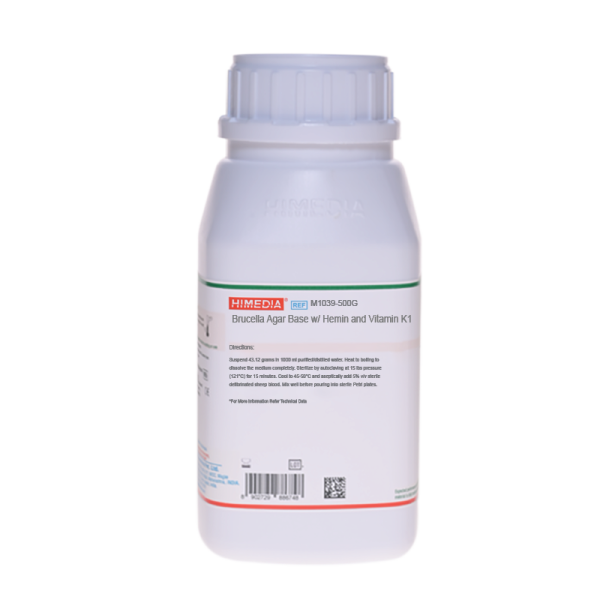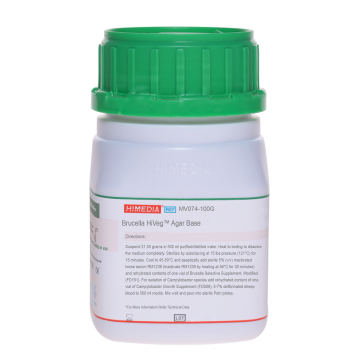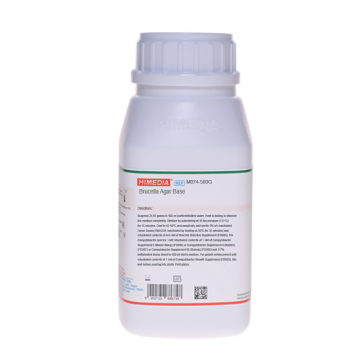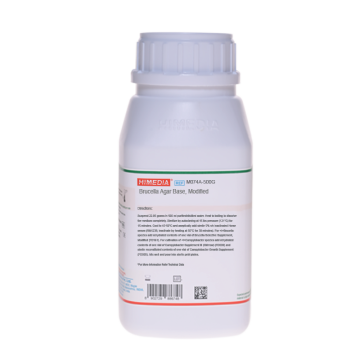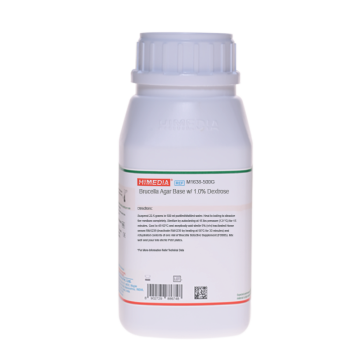 Your enquiry has been submitted
Your enquiry has been submitted
Brucella Agar Base w/ Hemin and Vitamin K
Intended Use:
For the isolation, cultivation and subculture of Brucella species and other anaerobes.
Composition**
| Ingredients | g/L |
|---|---|
| Tryptone | 10.000 |
| Peptone | 10.000 |
| Yeast extract | 2.000 |
| Dextrose (Glucose) | 1.000 |
| Sodium chloride | 5.000 |
| Sodium bisulphite | 0.100 |
| Hemin | 0.010 |
| Vitamin K1 | 0.010 |
| Agar | 15.000 |
Final pH (at 25°C): 7.0±0.2
**Formula adjusted, standardized to suit performance parameters
Directions
Suspend 43.12 grams in 1000 ml purified/distilled water. Heat to boiling to dissolve the medium completely. Sterilize by autoclaving at 15 lbs pressure (121°C) for 15 minutes. Cool to 45-50°C and aseptically add 5% v/v sterile defibrinated sheep blood. Mix well before pouring into sterile Petri plates.
Principle And Interpretation
The agents of brucellosis, Brucella species are normal flora of the genital and urinary tracts of many animals including goats, pigs, cows and dogs. Most humans acquire the disease through ingestion of contaminating milk or through occupational exposure; the disease is particularly common among abattoir workers (1).
Brucella Agar Base w/ Hemin and Vitamin K1 is a modified (2,3,4) and highly enriched medium, which can be used for the isolation of Brucella and other anaerobic bacteria (3,5).
The medium contain tryptone, peptone and yeast extract serves as sources of carbon, nitrogen, long chain amino acids and essential growth nutrients including B-complex vitamins. Dextrose serves as a source of energy. Addition of blood provides nutrients and helps to differentiate hemolytic organisms (3,5). Presence of hemin and Vitamin K1 supports growth of other fastidious bacteria like Bacteroides species and gram-positive spore bearers like Clostridium species (6).
Type of specimen
Clinical samples : urine samples, wounds
Specimen Collection and Handling
For clinical samples follow appropriate techniques for handling specimens as per established guidelines (7,8).
The specimen should be inoculated onto the plate (reduced earlier by placing under anaerobic conditions for 18-24 hrs) as early as possible. Swab cultures are directly streaked. Non-swab cultures are inoculated using an inoculating loop. Incubation is carried out anaerobically at 35°C for at least 48 hours; however, negative results should be reported only after incubation for 7 days.
Warning and Precautions
In Vitro diagnostic use only. For professional use only. Read the label before opening the container. Wear protective gloves/ protective clothing/eye protection/face protection. Follow good microbiological lab practices while handling specimens and culture. Standard precautions as per established guidelines should be followed while handling clinical specimens. Safety guidelines may be referred in individual safety data sheets.
Limitations
- 1. Individual organisms differ in their growth requirement and may show variable growth patterns on the medium.
- 2. Each lot of the medium has been tested for the organisms specified on the COA. It is recommended to users to validate the medium for any specific microorganism other than mentioned in the COA based on the user's unique requirement.
- 3. All presumptive anaerobic organisms must be identified by confirmatory test.
Performance and Evaluation
Performance of the medium is expected when used as per the direction on the label within the expiry period when stored at recommended temperature.
Quality Control
Appearance Light yellow to tan homogeneous free flowing powder
Gelling Firm, comparable with 1.5% Agar gel.
Colour and Clarity of prepared medium Basal medium :Light amber coloured clear to slightly opalescent gel. After addition of 5% v/v sterile defibrinated blood: Cherry red coloured opaque gel forms in Petri plates
Reaction Reaction of 4.31% w/v aqueous solution at 25°C. pH: 7.0±0.2
pH 6.80-7.20
Cultural Response
Cultural characteristics observed in presence of 10% CO2 with added 5% v/v sterile defibrinated sheep blood, after an incubation at 35-37°C for 48 hours.
| Organism | Inoculum (CFU) | Growth | Recovery |
|---|---|---|---|
| Bacteroides fragilis ATCC 25285 | 50-100 | good-luxuriant | >=50% |
| Clostridium perfringens ATCC 13124 (00007*) | 50-100 | good-luxuriant | >=50% |
Key: *Corresponding WDCM numbers.
Storage and Shelf Life
Store below 10-30°C in a tightly closed container and the prepared medium at 2-8°C. Use before expiry date on the label. On opening, product should be properly stored dry, after tightly capping the bottle in order to prevent lump formation due to the hygroscopic nature of the product. Improper storage of the product may lead to lump formation. Store in dry ventilated area protected from extremes of temperature and sources of ignition Seal the container tightly after use. Product performance is best if used within stated expiry period.
Disposal
User must ensure safe disposal by autoclaving and/or incineration of used or unusable preparations of this product. Follow established laboratory procedures in disposing of infectious materials and material that comes into contact with clinical sample must be decontaminated and disposed of in accordance with current laboratory techniques (7,8).
Reference
- 1. Baron E. J., Finegold S. M., (Eds.), 1990, Bailey and Scotts Diagnostic Microbiology, 8th Ed., The C.V. Mosby Co., St. Louis.
- 2. Sutter V. L., Citron D. M. and Finegold S. M., 1985, Wadsworth Anaerobic Bacteriology Manual, 4th Ed., Star Publishing Co., Belmont, Ca.
- 3. MacFaddin J. F., 1985, Media for Isolation-Cultivation-Identification-Maintenance of Medical Bacteria, Vol. I, Williams and Wilkins, Baltimore
- 4. Onderdonk A. B., Weinstein W. M., Sullivan N. M. and Bartlett J. G., 1974, Infect. Immun., 10:1256.
- 5. Gibbons and MacDonald, 1960, J. Bacteriol., 80:164.
- 6. Zennette, Balows, Hausler and Shadomy, (Eds.), 1985, Manual of Clinical Microbiology, 4th Ed., ASM, Washington, D.C.
- 7. Isenberg, H.D. Clinical Microbiology Procedures Handbook 2nd Edition.
- 8. Jorgensen, J.H., Pfaller, M.A., Carroll, K.C., Funke, G., Landry, M.L., Richter, S.S and Warnock., D.W. (2015) Manual of Clinical Microbiology, 11th Edition. Vol. 1.
| Product Name | Brucella Agar Base w/ Hemin and Vitamin K |
|---|---|
| SKU | M1039 |
| Product Type | Regular |
| Physical Form | Powder |
| Origin | Animal |
| Packaging type | HDPE |
| References | 1. Baron E. J., Finegold S. M., (Eds.), 1990, Bailey and Scotts Diagnostic Microbiology, 8th Ed., The C.V. Mosby Co., St. Louis. |
| Customized Product Available | No |



